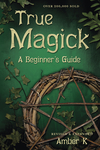Magick That Doesn’t Look Like Magick

A great deal of magickal work looks magickal in a deliciously Witchy or wizardly way. Chanting voices echoing in a darkened chamber, arabesques of incense smoke rising from a candlelit altar, a robed priestess lifting her athame and evoking the Elemental powers … even the most mundane of muggles would know what’s going on, and feel a shiver down his spine.
Yet experienced teachers always point out to aspiring novices that the magick is not in the ritual tools, or the costumes, or the candles and incense. The magick is in you: your mind, your imagination, your will, your disciplined focus and control of energies within and around you.
And having made this crucial point, many teachers immediately turn to the great “toys” that so many of us love: chalices and wands, swords and anointing oils, pretty crystals and polished stones, herbs and votive lights and … well, the list is endless. And endlessly fascinating. There is a part of each of us that delights in ritual goodies; call it your Inner Child, Younger Self, Huna, Lower Soul, or whatever you wish. That level of personality wants nice smells and bright colors and something tasty in the chalice; and it plays a key role in the success of any spell, so we want to keep it interested and happy.
But if the essence of magick is inside you, as focus and will and so on, shouldn’t it be at least possible to work magick without the toys and props and robes? It is possible. It is not easy, and Younger Self must still be involved; but adepts and masters perform such magick every day. It might be happening next to you on a crowded bus by the lady who looks like she is dozing, or by the guy sitting under a tree in the park who seems to be meditating.
Every experienced magician knows about such magick, but oddly, it rarely shows up in books on the subject. It is so rarely discussed in any depth that it doesn’t have a name—or didn’t. When the folks at Llewellyn told me about their plan to issue a fifteenth anniversary edition of True Magick: A Beginner’s Guide, I thought that this might be a good opportunity to illuminate this rather mysterious, elusive form of the Art.
I surveyed some respected magicians of my acquaintance and asked them: “What do you call this kind of magick? Does your tradition have a name for it?” Everyone I spoke to knew what I was talking about; a few had names for it within their tradition, names I hadn’t heard. Others had suggestions: “Just call it ‘propless magick!’”
More work, more discussion, and finally I had names that worked for me (and a number of magicians who got to be my “customer focus group”). Ready? Intrinsic magick is magick performed only with the tools that are part of you: your body, your voice, your mind and your emotions. Inner magick is a subset of that, and it uses no externally visible tools: no voice, no dancing, no sacred mudras; to the observer, the magician sits silent and motionless. Change is happening, energies are moving, but the process is internal.
And just for the sake of clarity, either the intrinsic or inner magician can perform virtual magick, using tools (athame, wand, pentacle, Tarot cards, etc.) that are not present on the material plane.
While the new edition of True Magick discusses these forms, it also covers other styles: nature magick and a simplified ceremonial magick that includes all the bells and whistles. The truth is that different people are attracted to different ways of practicing the Art of magick; and that it is normally better to develop and use a style that feels natural and comfortable for you, rather than forcing yourself into an approach that happens to work for someone else.
Above all, avoid the “One True Path” gurus who claim that their method is the only real, genuine, right way to do magick. Yes, magick is based on certain principles, but any system that honors and flows from these basic tenets can work—and one of them will work best for you.
My recommendation is that you try several different systems, including intrinsic and inner magick, and then choose your magickal path. Your temple may turn out to be a ceremonial chamber filled with amazing tools and implements, a quiet spot in the woods under your favorite tree, your kitchen table or the space at the center of your being where only you can go. If you can go there and transform your inner and outer worlds for the better, no matter what techniques you use, then you are practicing true magick.
About Amber K
Related Products


is subject to certain Terms and Conditions